Next: DC Operating Point Up: ch4 Previous: Diodes
A Bipolar Junction Transistor (BJT) has three terminals connected to three doped semiconductor regions. In an NPN transistor, a thin and lightly doped P-type base is sandwiched between a heavily doped N-type emitter and another N-type collector; while in a PNP transistor, a thin and lightly doped N-type base is sandwiched between a heavily doped P-type emitter and another P-type collector. In the following we will only consider NPN BJTs.
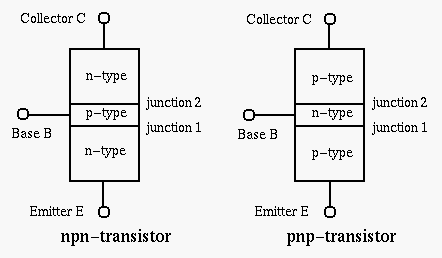
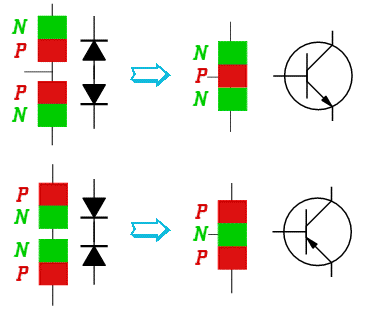
In many schematics of transistor circuits (especially when there exist a large number of transistors in the circuit), the circle in the symbol of a transistor is omitted. The figures below show the cross section of two NPN transistors. Note that although both the collector and emitter of a transistor are made of N-type semiconductor material, they have totally different geometry and therefore can not be interchanged.
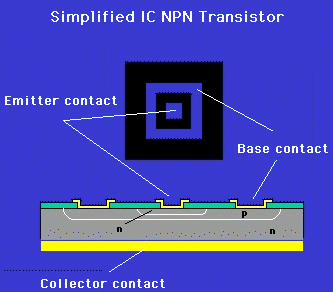
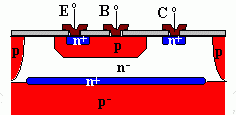
All previously considered components (resistor, capacitor, inductor, and diode) have two terminals (leads) and can therefore be characterized by the single relationship between the current going through and the voltage across the two leads. Differently, a transistor is a three-terminal component, which could be considered as a two-port network with an input-port and an output-port, each formed by two of the three terminals, and characterized by the relationships of both input and output currents and voltages.
Depending on which of the three terminals is used as common terminal, there can be three possible configurations for the two-port network formed by a transistor:

The CB configuration can be considered as a 2-port circuit. The input
port is formed by the emitter and base, the output port is formed by
the collector and base. Two voltages 




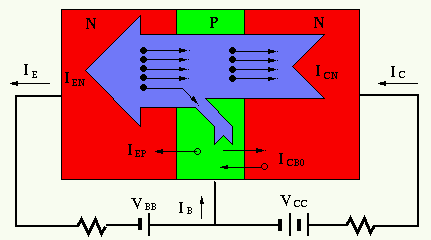

The polarity of 



The behavior of the NPN-transistor is determined by its two PN-junctions:
 .
.
 . The percentage depends on the doping and geometry
of the material.
. The percentage depends on the doping and geometry
of the material.
 .
.
The current gain or current transfer ratio of this CB circuit,
denoted by 


 e.g. e.g. |
(8) |
 |
 |
 |
|
 |
 |
 |
|
 |
 |
 |
(9) |
The relationships between the current and voltage of both the input and output ports are described by the following input and output characteristics.
The input current 


 |
(10) |
 has little effect on
has little effect on  .
Here
.
Here  and
and  associated with the emitter-base PN-junction
satisfy the relationship for a diode:
associated with the emitter-base PN-junction
satisfy the relationship for a diode:
 |
(11) |
 .
.
The output current 


 |
(12) |
 , i.e., the CB junction is reverse
biased, the current
, i.e., the CB junction is reverse
biased, the current  only depends on
only depends on  . When
. When  ,
,
 is the current caused by the minority carriers crossing
the PN-junction. This is similar to the diode current-voltage
characteristics seen before, except both axes are reversed (the
polarity of
is the current caused by the minority carriers crossing
the PN-junction. This is similar to the diode current-voltage
characteristics seen before, except both axes are reversed (the
polarity of  and the direction
and the direction  are oppositely defined).
When
are oppositely defined).
When  is increased,
is increased,
 is
increased correspondingly. However, as higher
is
increased correspondingly. However, as higher  does not cause
more electrons from the emitter, it has little effect on
does not cause
more electrons from the emitter, it has little effect on  .
.
Note that when 

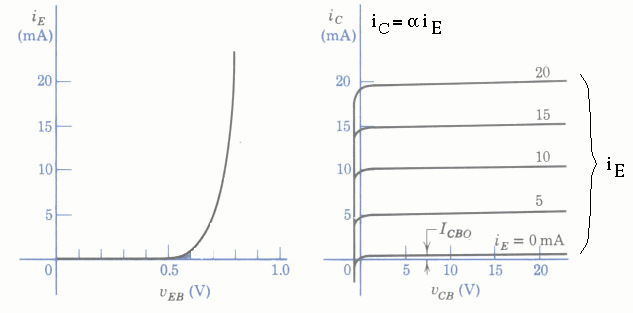
Two voltages 





 or or |
(13) |
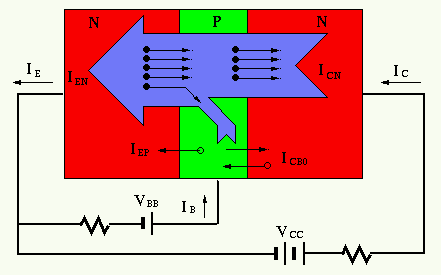

The CE configuration can be considered as a 2-port circuit. The input
port is formed by the emitter and base, the output port is formed by
the collector and emitter. The current gain of the CE circuit, denoted
by 


 |
(14) |
 , then
, then
 .
.
The two parameters 

 |
(15) |
The relationships between the current and voltage of both the input and output ports are described by the following input and output characteristics.
Same as in the case of common-base configuration, the EB junction of the common-emitter configuration can also be considered as a forward biased diode, the current-voltage characteristics is similar to that of a diode:
 |
(16) |
 .
.  has little effect on
has little effect on  .
.
 (in linear region) (in linear region) |
(17) |
 depends on the current
depends on the current  , which in
turn depends on
, which in
turn depends on  . However, as higher
. However, as higher  does not cause
more electrons from the emitter, it has little effect on
does not cause
more electrons from the emitter, it has little effect on  .
.
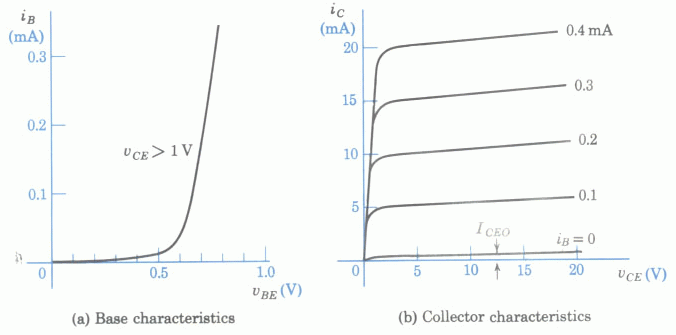
The relationship between the input and output currents of both CB and CE configurations is summarized below:
 |
(18) |

 |
 |
 i.e., i.e., |
|
 |
 |
 |
(19) |

 |
 |
 i.e., i.e., |
|
 |
 |
 |
(20) |
The collector characteristics of the common-base (CB) and common-emitter (CE) configurations have the following differences:
 is slightly less than
is slightly less than  , while
in CE circuit
, while
in CE circuit
 is much greater than
is much greater than  .
.
 when
when  ; while in CE circuit
; while in CE circuit  when
when  (as
(as
 has the effect of suppressing
has the effect of suppressing  ).
).
 will slightly increase
will slightly increase  but more
greatly increase
but more
greatly increase
 , thereby causing more
significantly increased
, thereby causing more
significantly increased  .
.
 in CB is a function of two variables
in CB is a function of two variables  and
and  ,
but the former is much more significant then the latter.
,
but the former is much more significant then the latter.
 in CE is a function of two variables
in CE is a function of two variables  and
and  ,
but the former is much more significant then the latter.
,
but the former is much more significant then the latter.
 in CB is a function of two variables
in CB is a function of two variables  and
and  .
When
.
When  is small, its slight increase will cause significant increase
of
is small, its slight increase will cause significant increase
of  . But its further increase will not cause much change in
. But its further increase will not cause much change in  due
to saturation (all available charge carriers travel at the saturation velocity
to arrive at collector C),
due
to saturation (all available charge carriers travel at the saturation velocity
to arrive at collector C),
 is mostly determined by
is mostly determined by  .
.
 in CE is a function of two variables
in CE is a function of two variables  and
and  .
When
.
When  is small (
is small (
 ), its slight increase will cause
significant increase of
), its slight increase will cause
significant increase of  . But when
. But when
 , its further increase
will not cause much change in
, its further increase
will not cause much change in  due to saturation (all available charge
carriers travel at the saturation velocity to arrive at collector C),
due to saturation (all available charge
carriers travel at the saturation velocity to arrive at collector C),
 is mostly determined by
is mostly determined by  .
.


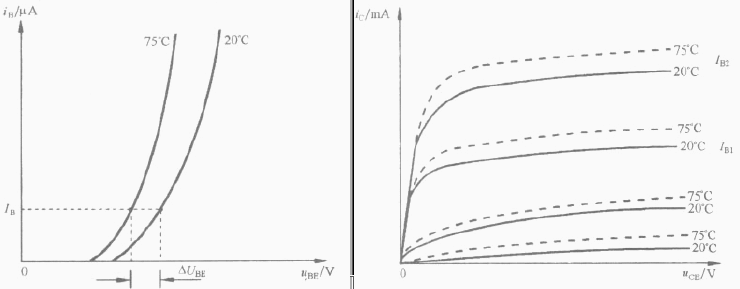
Various parameters of a transistor change as functions of temperature.
For example, 